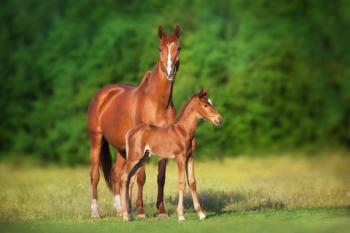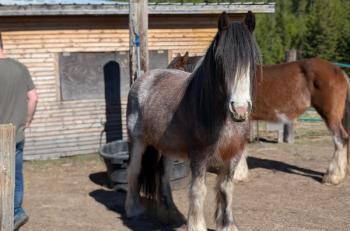
Underwater treadmill exercise in horses (Proceedings)
The use of underwater treadmill exercise for training and rehabilitation of horses has become increasingly popular in recent years. Many claims are made as to the usefulness of this form of exercise in horses; although relatively little published information is available to substantiate these assertions. In humans, underwater treadmill therapy has long been recognized for benefits in rehabilitation.
The use of underwater treadmill exercise for training and rehabilitation of horses has become increasingly popular in recent years. Many claims are made as to the usefulness of this form of exercise in horses; although relatively little published information is available to substantiate these assertions. In humans, underwater treadmill therapy has long been recognized for benefits in rehabilitation. In horses there is a lack of information on physiological responses, protocols, guidelines and implementation of this therapy. This paper will review principles of underwater exercise and currently available knowledge of underwater treadmill exercise in horses.
Claimed Benefits of Underwater Exercise in Horses
• Reduces:
Loading on painful or healing structures
Pain in joints with degenerative joint disease
Muscle spasm, joint stiffness
Development of muscle atrophy
Lay-up time if underwater exercise continues when land exercise is restricted
Edema
• Increases:
Resistance for muscles during exercise
Tone in hypotonic muscle parts
Muscle mass and strength
Joint range of motion
Soft tissue extensibility
Cardiovascular fitness and endurance
Circulation which promotes healing
Support to limbs – reducing chance of injury
Relaxation
Physical Properties of Water
In order to more fully understand the effects of underwater versus land treadmill exercise some understanding of the physical properties of water is needed.
Hydrodynamics:
Hydrodynamics describes movement through water and depends on the speed and direction of the immersed object. Strength training results from the increased resistance to movement underwater when compared to air. Resistance to movement in water increases with an object's surface area and speed, and this can be exploited by increasing the surface area of a limb or body or by adjusting the speed of movement under water.
Density:
Density is the relationship between mass and volume and determines whether an object will sink or float. Lean heavily muscled animals (such as horses) float less easily than animals with a greater amount of body fat.
Buoyancy:
When a body is immersed in water it is subject to the opposing forces of gravity and buoyancy and it experiences an upward thrust equal to the weight of the fluid displaced (Archimedes principle of buoyancy). Buoyancy is one of the major reasons for the use of aquatic environments in rehabilitation therapy in humans and small animals, as weight bearing is reduced, resulting in less stress on bone, joints and connective tissue. The amount of weightlessness depends largely on the percentage of the body that is below the water's surface. In humans it has been calculated that approximately 90% of body weight is supported when immersed to the neck and this decreases as the water level decreases. When dogs are immersed to the level of the greater trochanter, 38% of body weight is borne. As water decreases to the level of the lateral femoral condyle, weight bearing is increased to 85% of body weight and at the lateral malleolus is 91% of body weight. (Tragauer and Levine 2002). The effect of different water levels on weight bearing in horses is unreported to date. Due to the large amount of body weight in the proximal versus distal part of the equine body it could be anticipated that minimal reduction occurs until the trunk of the horse is substantially submersed, as is seen with below ground water treadmills. In addition, the large proximal muscle mass in horses may cause less reduction in weight bearing, until a larger portion of the body is submerged, when compared to dogs. It is also possible that a difference exist between breeds with a larger proportion of body fat (such as native ponies) when compared to more athletic/heavily muscled breeds such as Quarter Horses.
Turbulence:
As an animal moves through water the amount of turbulence it creates depends on the speed of movement and its shape. Increased speed produces increased turbulence and turbulence causes drag which increases the difficulty and effort. The resistance that turbulence provides can be used to build strength and can be increased by swimming against jets. In small animals, floats or aqua fins are sometime incorporated to increase effort required.
Viscosity:
Viscosity is caused by resistance from cohesive or attractive forces between liquid molecules. The resistance created by viscosity is proportional to the velocity of movement through the liquid. Viscosity decreases as water temperature increases and so it may be easier for weaker muscles to move in warm water than cold water.
Surface Tension:
Water molecules have a greater tendency to adhere together at the surface and so resistance to movement is slightly greater at the surface. The result is that more effort is required to lift a limb out of the water than to move it under the water.
Hydrostatic pressure:
Hydrostatic pressure is the pressure exerted by water on an immersed body that is equal in all directions and proportional to depth. In deeper water this may assist in venous return.
Refraction:
Light will be refracted as it passes from air to water which can make viewing of an animal moving through water more difficult.
Physiologic responses
Exercising in water causes different physiological responses compared to exercising on land. Several studies of water treadmill exercise have been performed in humans and fewer studies have been performed in horses. The following will summarize some of the currently known responses to underwater treadmill exercise in horses and humans.
Acclimation response
Introducing a horse to a foreign experience such as an underwater treadmill is likely to induce a stress response. This will have effects of various metabolic processes including elevation of heart rate. Nankervis and Williams (2006) found that a minimum of 2 x 15 minutes sessions were required to achieve behavioral acclimation and a steady heart rate in horses.
Energy expenditure
The opposing effect of buoyancy and resistance to movement underwater affect energy expenditure and depends on water depth, temperature and exercise duration and velocity. Exercising in colder water also requires more energy expenditure to maintain core body temperature.
Walking / trotting:
Humans walking or jogging in waist deep water at 31 C will use the same amount of energy compared to moving at ½ - ⅓ of the speed on land (Evans 1978). The rate of oxygen uptake (VO2) increases curvi-linearly when walking in water at depths of ankle, knee, thigh and waist at speeds of 2 to 4.5 miles/hour (Glaim and Nicholas 1989). However, in waist deep water, when speeds were greater than 5 miles/hour, oxygen uptake was similar to that on land at the same speed. This effect may have been due to buoyancy counteracting the effect of water resistance at higher speeds. Whether the opposing effects on oxygen uptake of speed and buoyancy occur in horses is unknown, however, it could be an important factor to consider in deep water, especially if one aim of the treatment is fitness training.
Water temperature:
In humans undergoing underwater exercise, energy expenditure is increased when water temperature is below 26 C. This is also likely to occur in horses exercising in cold water, due to the extra energy required to maintain core body temperature. The magnitude of effect of temperature is likely dependent on the amount of body fat, the intensity and duration of exercise.
VO2 max and fitness:
In humans, heart rate is often lower during exercise in water compared with exercise on land at the same maximal oxygen uptake, and is dependent on exercise intensity and water temperature. Additionally, the relationship of VO2 to heart rate during exercise in water compared to that on land is variable and dependent on several factors, including exercise intensity and water temperature.
Maximum heart rate, blood lactate and maximum oxygen uptake are generally lower in water compared to land running, suggesting that the rate of work achieved at exhaustion is lower than when running on land (Cureton 1997). This is important to consider if using heart rate to monitor exercise as one should not base programs for under water exercise on maximal heart rates measured on land.
One study looked at the effects of underwater treadmill training on blood lactic acid concentration, hemoglobin content and heart-rate variability in horses (Voss et al 2002). Seven horses were evaluated at different speeds (walk and trot) and at different water levels (none, water above carpus and water above elbow) for 30 min. Compared to rest, there was no significant increase in lactic acid concentration in any horses at any speed or water level. Hemoglobin content and heart rates did increase with exercise. The conclusion from this study was that the training-protocol used for the aqua-treadmill exercises represented a moderate aerobic work load for horses.
A recent study looking at the comparative efficacy of water and land treadmill training for overweight adult humans indicated that both were equally capable of improving fitness and body composition but underwater training showed a tendency to induce an increase in lean body mass when compared to land training (Greene et al. 2009). Thus, while underwater treadmill training can be used for fitness training, current evidence does not support that it will achieve fitness more quickly than similar exercise intensity on land.
Circulation:
When humans stand in water up to the neck, blood shifts from the lower limbs and the abdomen to the thorax. This causes an increase in central venous pressure, left ventricular end-diastolic volume, stroke volume and cardiac output while also decreasing systemic vascular resistance at rest, and during submaximal exercise. It is unknown whether water has the same effect in horses.
Thermoregulation:
Heat dissipation during land exercise occurs largely by skin surface evaporation whereas when submerged in water, heat is lost or gained by convection or conduction. Thus, core body temperature when exercising in water is stable in only a very narrow range of water temperatures. Exercising in warm water over 33 C can cause a feeling of exhaustion due to elevated core body temperature. When exercising in cold water below 25 C, heat loss results in adjustments in metabolic and cardiovascular functions that maintain body temperature. For humans who are exercising optimal pool temperature is around 28-30 C. Limited studies of water temperature during underwater treadmill exercise have been performed to date and optimal water temperature for horses is unknown. Current recommendations are to adjust water temperature based on the needs of the patient, speed of exercise and depth of immersion.
Effect of Water level on Equine Joint Kinematics
A pilot study of one horse was performed (Trumble 2009) to determine percent change in joint angles with different water levels at constant a speed of 2 mph. When water was at the level of the fetlock; fetlock, carpal, and hock flexion and extension were increased. At hock level water;
fetlock extension, fetlock flexion, carpal extension and hock flexion increased, while carpal flexion and hock extension decreased. At stifle level water; fetlock extension, fetlock flexion and hock flexion increased, while carpal flexion and hock extension decreased. At stifle level water there was no change in carpal or hock extension. Thus, although further horses should be analyzed, these initial results indicate that one water level does not have the same effect on each joint and thus it is important to consider the advantages and disadvantages of changing range of motion versus decreased weight bearing for each individual joint.
Contraindications for Underwater Treadmill Exercise
• Surgical incisions or open, infected or draining wounds
• Systemic infection or compromise
• Diarrhea
• Cardiovascular/respiratory compromise
Underwater Treadmill Exercise Regimen
As mentioned earlier there is little information available regarding protocols, guidelines and implementation of this therapy. General guidelines for formulation of an underwater treadmills session are based around the following principles:
1.Warm up/Cool down. Can be performed underwater and/or on dry land.
2. Intensity
a. Intensity of exercise is controlled through depth of water and speed of walking. The intensity of exercise should generally be increased as horse adapts and strength improves.
b. Water depth is also adapted to target or avoid over-working certain areas. For instance, more joint flexion at the hocks and carpi are noted at lower water depths and so this can be used when improving range of motion is the focus of therapy. When the aim of treatment is to strengthen the topline and avoid over flexing or extending the lower limb joints, a higher water level is used.
3. Duration
a. This is dependent on many factors including fitness level, type of injuries present, anxiety etc. Sometimes interval training concepts can be used by interspersing faster walking periods with slower walking to allow the horse to recover in between.
4. Monitoring
a. Heart rate monitoring can be used as long as target heart rates are not based on those used for land exercise. Respiratory rate increase can also give an indication of fatigue.
5. Frequency
a. This depends on the aim for the horse. Generally it is recommended to carry out sessions 2-3 times per week. However the authors have also noted good clinical responses when horses are exercised weekly or even daily for a shorter period.
6. Progression
a. Treatment should be progressive to allow adaptation and strengthening effects and prevent a plateau of fitness. The horse should be evaluated carefully prior to the next session to observe for any worsening or improvement in clinical signs as this will help guide the next treadmill session.
Newsletter
From exam room tips to practice management insights, get trusted veterinary news delivered straight to your inbox—subscribe to dvm360.






